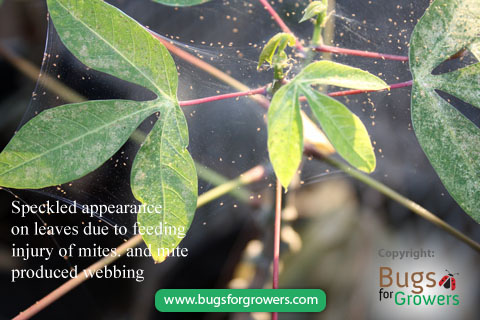Biological control of four species of pest mites with gall midgefly, Feltiella acarisuga
Several species of pest mites including two spotted spider mite (Tetranychus urticae), brown almond mite (Bryobia rubrioculus), carmine spider mite (Tetranychus cinnabarinus) and European red mite (Panonychus ulmi) are known to cause a serious damage to many agricultural, horticultural and ornamental plants. However, two-spotted spider mites (red spider mites) are the most common polyphagous mite species that attacks most of the vegetable and fruit crops all over the world. These mites feed by sucking cell sap (juice) from leaves. This feeding injury gives mottled and speckled (Fig.1) appearances to leaves. Also, while feeding both adults and nymphs of these mites produce webbing that reduces aesthetic value of many ornamental plants (Fig. 1). The feeding by mites also affects the process of photosynthesis, which in turn reduces plant’s ability to make its own food. Heavy infestations of these mites generally result into leaf yellowing and desiccation, leaf drop, death of plant and yield loss of many crops including various kinds of beans, canola, cotton, cucumber, eggplant, melon, peanut, pepper, strawberries, potato, roses, soybean and tomato.

Biological control of mites
Several chemical pesticides (Acaricides) may be currently available for the control of pest mites but their use is restricted due to their detrimental effects on human health and the environment. Therefore, natural enemies including predatory mites and midge flies that can be used as environment and human friendly biological control alternatives to chemical pesticides to manage populations of pest mites. Several species of predatory mites including Amblyseius swirskii, Neoseiulus californicus, Neoseiulus fallacis and Phytoseiulus persimilis have showed a potential to use as biological control of pest mite but this blog focuses on the use of gall midge flies, Feltiella acarisuga as biological control agents to control of four different species of pest mites.
What are gall midge flies, Feltiella acarisuga?
Adult gall midges Feltiella acarisuga are small about 1.5 to 2 mm long pinkish brown colored, short-lived flies. Adult gall midge flies generally do not feed on mites but all of their larval stages are predatory in nature and feed on all the stages of pest mites. Females lay about 30 to 40 shiny eggs in the colony of pest mites. Eggs hatch into small brown colored larvae. Immediately after hatching from eggs, larvae start feeding on the immature stages and eggs of pest mites especially two spotted spider mite, Tetranychus urticae. While feeding, larvae of midge fly develop through four developmental stages/instars. The matured 4th instar larvae generally pupate in silken cocoons on underside of the leaves and emerge as adults after 7-10 days of pupation and life cycle continues.
The gall midge flies, Feltiella acarisuga are effective against the following pest mites
- Two spotted spider mite, Tetranychus urticae
- Brown almond mite, Bryobia rubrioculus
- Carmine spider mite, Tetranychus cinnabarinus
- European red mite, Panonychus ulmi
How gall midge fly, Feltiella acarisuga work as a biological control agent?
When released as biological control agents in the greenhouses or fields, adults of gall midge flies actively search for pest mite colonies to lay eggs. Once pest mite colonies are found females of gall midge fly lay eggs in the or near the mite colonies. Depending upon temperature, these eggs hatch into tiny larvae within a week. These newly hatched young larvae of Feltiella acarisuga immediately start feeding on all the stages including eggs, nymphs and adults of spider mites. For example, single Feltiella acarisuga larva can eat more than 15 adults, 50 eggs, 25 nymphal stages of pest mites. These predatory flies perform better against pest mites when optimum temperature is between 68oF (20oC) and 86oF (27oC) and relative humidity is between 70 and 90%.
When, how and how many gall midge Feltiella acarisuga flies should be release for the effective control of pest mites?
As biological control agents, adults of gall midge flies should be released when there is a heavy infestation of pest mites. These predatory flies are supplied in the containers as pupae on the leaves. During transit adult flies may emerges from pupae. When package is arrived and if you are ready to release midge flies, make sure the lids of containers are perforated to allow gall midge fly adults to escape. It is recommended to release gall midge flies immediately upon their arrival by placing the perforated containers at different places in the greenhouses or gardens. To build up population of gall midge flies in the targeted areas, release about 2-3 flies per 50 square foot area (4.65 square meter area) every week for 4 weeks. To achieve better control of mites in a large area, release 200- 800 gall midge flies per hectare (2.5 acres) weekly for 4-5 weeks. If you are not ready to release these predatory flies, store them in a dark place at cooler temperatures at 10-15oC or 50-59oF for only a couple of days.
Research Papers
- Gillespie, D.R., Opit, G. and Roitberg, B. 2000. Effects of temperature and relative humidity on development, reproduction, and predation in Feltiella acarisuga (Vallot) (Diptera: Cecidomyiidae). Biological Control 17: 132-138.
- Mo, T.L. and Liu, T.X. 2006. Biology, life table and predation of Feltiella acarisuga (Diptera: Cecidomyiidae) feeding on Tetranychus cinnabarinus eggs (Acari : Tetranychidae). Biological Control 39: 418-426.
- Xiao, Y.F., Osborne, L.S., Chen, J.J. and McKenzie, C.L. 2013. Functional responses and prey-stage preferences of a predatory gall midge and two predacious mites with twospotted spider mites, Tetranychus urticae, as host. Journal of Insect Science 13: article number 8.
- Xiao, Y.F., Osborne, L.S., Chen, J.J., Mckenzie, C., Houben, K. and Irizarry, F. 2011. Evaluation of corn plant as potential banker plant for supporting predatory gall midge, Feltiella acarisuga (Diptera: Cecidomyiidae) against Tetranychus urticae (Acari: Tetranychidae) in greenhouse vegetable production. Crop Protection 30: 1635-1642.
